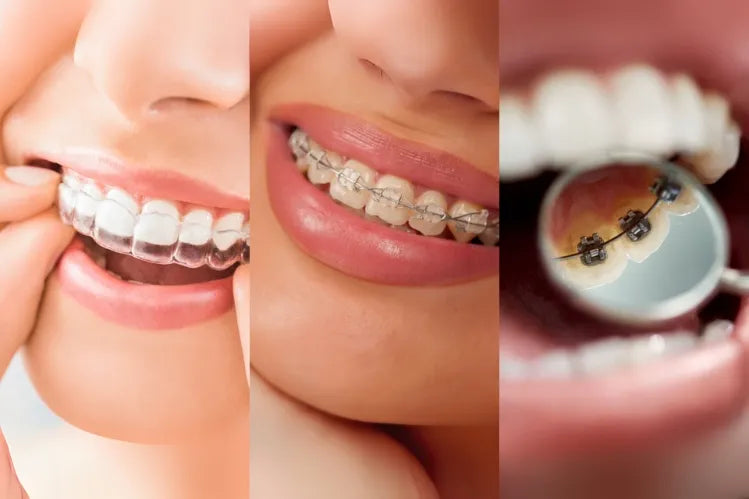
Table of Contents
- What Are Braces?
- What Are the Four Types of Braces?
- Ceramic Braces
- ALIGNERCO Clear Aligners
- Comparison of Different Types of Braces
- Which Type of Braces Is the Most Painful?
- Which Type of Braces Works Faster?
- How Can I Find The Best Braces For Myself?
- Braces and Their Type: All You Need To Know
- FAQs
Orthodontic treatment with braces is a very common and effective approach to move teeth into a straighter position, correcting alignment and bite issues, not only making more aesthetic smiles but also allowing for better oral hygiene. Misalignment of your teeth can cause problems with chewing, speech issues, jaw pain, tooth decay, and gum disease.
Braces move and adjust the placement of your teeth over time, resolving both cosmetic and functional problems with your dental health.
With the advancements in dentistry, many different types of orthodontic treatment options are available to accommodate various needs, preferences, and costs. Patients today are able to select from traditional metal brackets, ceramic braces, hidden lingual braces, and removable clear aligners like ALIGNERCO for tooth adjustments at home.
In this blog, we’ll explore each option in detail, breaking down how they work, their pros and cons, and who they might be best suited for. By the end, you'll have a better understanding of the available options and feel more confident choosing the best braces for your teeth.
What Are Braces?
Braces are dental appliances to straighten crooked teeth. They apply pressure to move teeth into the desired position. They can change both the appearance and function of your teeth. The whole process can take months and sometimes even years, depending on the severity of the dental problem, the age of the patient, and how well the patient follows the orthodontist's recommendations.
What Are the Four Types of Braces?
Braces can be classified into four major types, along with their respective advantages and disadvantages. Here are the types of dental braces:
Traditional Braces

The most widespread type of dental braces is traditional braces. They consist of metal brackets attached to each tooth. A wire is passed through these brackets, and its continuous tightening aids in the gradual movement of the teeth into their correct position. Traditional braces work efficiently in the most severe cases of misalignment.
Pros of Traditional Braces
- High Efficiency: They work well for complex cases.
- Durability: Made of strong materials, these last throughout the journey.
- Economically Viable: These are generally the least expensive of all kinds of braces available.
Cons of Traditional Braces
- Visibility: Metal brackets can be seen from a distance.
- Discomfort: There will be discomfort at the beginning of the placement, while adjustments may create soreness.
- Diet Restrictions:
- Certain foods must be avoided to prevent dislodging or breaking the appliance.
Ceramic Braces

Ceramic braces are similar to traditional braces in design, but this teeth straightening method uses tooth-colored materials for a less visible appearance. The brackets are made from ceramic, same as the natural color of your teeth. This helps them blend with your teeth, making them a popular choice among those who want a more discreet option.
Pros of Ceramic Braces
- Aesthetic Appeal: They can be called aesthetic braces as they are less visible than ones made of steel or metal.
- Very Effective: It works for mild to complex cases of misaligned teeth.
Cons of Ceramic Braces
- Brittle: Since they are more fragile, ceramic brackets are liable to break.
- Price: Ceramic braces are more expensive than metal braces.
- Stains: Brackets can get stains due to improper care.
Lingual Braces

Lingual braces are a type of dental braces placed behind the teeth, making them invisible from the front. They are an excellent solution for those who wish to straighten their teeth discreetly.
Pros of Lingual Braces
- Invisible: Completely out of sight.
- Efficient: Works on different types of alignment issues.
- Customized: Brackets are customized for each tooth.
Cons of Lingual Braces
- Cost: More expensive than traditional and ceramic braces.
- Comfort: Initial discomfort is felt and may hamper speech.
- Maintenance: Harder to clean because of their placement.
ALIGNERCO Clear Aligners

Clear aligners are the best braces for adults, because they work as an invisible alternative to traditional braces, featuring clear plastic trays that fit over the teeth. ALIGNERCO Clear Aligners are removable and highly convenient for most individuals, with mild to moderate alignment issues.
One common question is: Can you eat with braces? With clear aligners, the answer is yes, but only after removing them. This gives users more freedom during meals compared to fixed braces, which come with food restrictions to avoid damaging brackets and wires.
Pros of Clear Aligners
- Aesthetic: Virtually invisible; a very discreet option.
- Removable: Can be taken out whilst eating and during cleaning.
- Comfortable: Smooth plastic causes little to no irritation.
- Cost: More affordable than other types of braces, with brands like ALIGNERCO.
Cons of Clear Aligners
- Effectiveness: They are not used for severe cases.
- Discipline: Must be worn to achieve good effectiveness.
Comparison of Different Types of Braces
| Factors | Traditional Braces | Ceramic Braces | Lingual Braces | ALIGNERCO Clear Aligners |
|---|---|---|---|---|
| Appearance | Highly visible | Less-visible/ tooth-colored | Completely hidden | Nearly invisible |
| Effectiveness | Best for a severe cases | Moderate to severe cases | Most alignment issues | Mild to moderate issues |
| Comfort | Can cause discomfort | Can cause discomfort | May affect speech | Smooth and comfortable |
| Cost of braces | Moderate to high | Expensive | Most expensive | Affordable |
| Maintenance | Difficult to clean | Prone to staining | Harder to clean | Easier to clean |
| Treatment Duration | 18-24 months | 18-24 months | 18-24 months | 4-6 months |
| Visibility | Highly noticeable | Less noticeable | Completely hidden | Nearly invisible |
Which Type of Braces Is the Most Painful?
The level of discomfort varies depending on the type of braces and the individual’s pain tolerance.
- Traditional metal braces often cause discomfort in the start due to brackets and wires applying continuous pressure.
- Ceramic braces cause similar discomfort, especially early on in the treatment.
- Lingual braces can be more uncomfortable initially because of their placement on the back of the teeth, which may also affect speech.
- Clear aligners are generally considered the most comfortable option, as they are smooth, removable, and exert gentler force. Although users may still experience pressure during adjustment periods.
Which Type of Braces Works Faster?
This varies according to the braces and the severity of misalignment. Below is a general speed indicator of which types of braces act fastest:
Traditional Metal Braces (Fastest for Severe Cases)
Traditional braces remain the gold standard for complex orthodontic cases.
- Effective for severe misalignment or bite issues.
- Treatment duration typically ranges from 12 to 24 months.
- Uses metal brackets and wires to apply continuous pressure on teeth.
Clear Aligners (Fastest for Mild to Moderate Cases)
Clear aligners, like those from ALIGNERCO, offer a discreet and efficient way to straighten teeth, especially for mild to moderate cases.
- Treatment can be completed in as little as 4-6 months.
- Must be worn for 20–22 hours per day for optimal results.
- Great for adults and teens seeking a convenient, removable solution.
Lingual Braces (Slower but Invisible)
These are similar to traditional braces but are fixed behind the teeth.
- Custom-made for each tooth, which can increase complexity.
- It may take 18 to 36 months, depending on the case.
- Often chosen for cosmetic reasons despite longer timelines.
Ceramic Braces (Comparable to Metal Braces)
Ceramic braces use tooth-colored brackets for a more aesthetic look.
- Similar mechanics and timeline to metal braces.
- Can stain without proper care.
- Treatment usually spans 12 to 24 months.
How Can I Find the Best Braces for Myself?
With various types of braces available today, it can be challenging to determine which option is best for your needs. Below are tips to help you choose the best braces for yourself.
Consult Your Doctor or Orthodontist
They will be able to make some specific recommendations according to your needs.
Budget
Braces are expensive, so it's important to choose a type that fits your budget.
Consider Your Lifestyle
For instance, if you engage in sports or other activities that could damage your braces, invisible braces are a great option because they are removable. This is especially true when choosing braces for teens, who often need solutions that are both durable and discreet to fit their active lifestyles.
Ask about Different Types Of Braces
Various braces are available in the market; therefore, consult your orthodontist about all possible options before deciding on your orthodontic treatment plan .
Fit for Braces
Once you have selected the type of braces you want, you will be fitted for braces. The fitting procedure will also include exposing you to some X-rays and developing impressions of your teeth for a custom-made appliance to fit into your mouth.
Wearing Braces
Following your orthodontist's instructions on wearing and caring for your braces is essential. Failure to adhere can damage the braces or extend the treatment duration.
Regular Visits to Your Orthodontist
Visit your orthodontist regularly after getting braces fitted on your teeth to keep a check on your progress.
Be Patient
It will take a while for your teeth to adapt to the braces, so be patient. But, in time, you will finally have those straight teeth you've wanted for so long.
Braces and Their Types: All You Need to Know
If you’re considering options for aligning your teeth, you’ll find a variety of choices available, including traditional metal braces, ceramic braces, lingual braces, and clear aligners. Among these, the debate between metal vs clear braces is particularly noteworthy.
Traditional metal braces are often the go-to for complex alignment issues, whereas clear braces offer a more aesthetically pleasing and less noticeable alternative. Each type of brace has its own set of advantages and disadvantages, so it's best to consult with your orthodontist to determine the most suitable option for your dental needs.
FAQs
1. How do I know what type of braces I need?
Your orthodontist will assess your dental condition and recommend the best type based on your alignment issues, lifestyle, and budget.
2. What type of braces look the best?
Clear aligners and ceramic braces are the most discreet and visually appealing options.
3. What's the most painful type of brace?
Lingual braces can be the most uncomfortable at first since they sit behind the teeth and may irritate the tongue.
Citations:
Professional, C. C. M. (2025v, June 30). Teeth Braces. Cleveland Clinic. https://my.clevelandclinic.org/health/treatments/24601-teeth-braces
Colgate. (n.d.-l). What are the different types of braces, and which is right for me? https://www.colgate.com/en-us/oral-health/adult-orthodontics/what-are-the-different-types-of-braces-and-which-is-right-for-me






